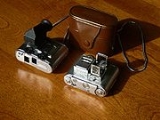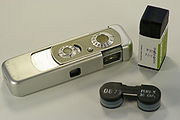
Subminiature photography
Encyclopedia




Photography
Photography is the art, science and practice of creating durable images by recording light or other electromagnetic radiation, either electronically by means of an image sensor or chemically by means of a light-sensitive material such as photographic film...
with unusually small camera
Camera
A camera is a device that records and stores images. These images may be still photographs or moving images such as videos or movies. The term camera comes from the camera obscura , an early mechanism for projecting images...
s using unusually small film format
Film format
A film format is a technical definition of a set of standard characteristics regarding image capture on photographic film, for either stills or movies. It can also apply to projected film, either slides or movies. The primary characteristic of a film format is its size and shape.In the case of...
s. It is distinct from photomicrography, photographing microscopic subjects with a camera which is not particularly small.
The term "miniature" was originally used to describe the 35 mm format, so cameras that used a format smaller than 35 mm were referred to as "sub-miniature". The smallest of these are often referred to as "ultra-miniature". In the interest of specificity, cameras that produce an image on the film smaller than the standard 135 film
135 film
The term 135 was introduced by Kodak in 1934 as a designation for cartridge film wide, specifically for still photography. It quickly grew in popularity, surpassing 120 film by the late 1960s to become the most popular photographic film format...
format (24×36 mm) are usually included in the genre. Small digital camera
Digital camera
A digital camera is a camera that takes video or still photographs, or both, digitally by recording images via an electronic image sensor. It is the main device used in the field of digital photography...
s are not included, because they don't use film. The smaller subminiature or ultraminiature cameras, particularly Minox, are associated with spy
SPY
SPY is a three-letter acronym that may refer to:* SPY , ticker symbol for Standard & Poor's Depositary Receipts* SPY , a satirical monthly, trademarked all-caps* SPY , airport code for San Pédro, Côte d'Ivoire...
ing.
Types
There are many subminiature cameras. MinoxMinox
The Minox is a subminiature camera conceived in 1922 and invented in 1936 by German-Latvian Walter Zapp, which Latvian factory VEF manufactured from 1937 to 1943. After World War II, the camera was redesigned and production resumed in Germany in 1948. Originally envisioned as a luxury item, it...
, followed by Tessina
Tessina
The Tessina is a high-quality 35 mm camera patented by Austrian chemical engineer Dr. Rudolph Steineck in Lugano Switzerland, manufactured by Siegrist in Grenchen Switzerland. It was introduced in 1957 and distributed by Steineck's company Concava S.A and remained in production up to 1996...
, GaMi
Gämi
Gämi is a village and suburb on the southeastern outskirts of Ashgabat, Turkmenistan, approximately 5 kilometres from the city centre. It is located in Annau District in Ahal Province and lies on the M37 highway which connects Ashgabat to Annau....
, Rollei
Rollei
Rollei is a German manufacturer of optical goods founded in 1920 by Paul Franke and Reinhold Heidecke in Braunschweig, Lower Saxony, and maker of the Rolleiflex and Rolleicord series of cameras...
, Yashica
Yashica
Yashica was a Japanese manufacturer of cameras.-History:The company began in December, 1949 in Nagano, Japan, when the Yashima Seiki Company was founded with an initial investment of $566. Its eight employees originally manufactured components for electric clocks...
, Mamiya
Mamiya
is a Japanese company that today manufactures high-end cameras and other related photographic and optical equipment. With headquarters in Tokyo, it has two manufacturing plants and a workforce of over 200 people...
, and Minolta
Minolta
Minolta Co., Ltd. was a Japanese worldwide manufacturer of cameras, camera accessories, photocopiers, fax machines, and laser printers. Minolta was founded in Osaka, Japan, in 1928 as . It is perhaps best known for making the first integrated autofocus 35mm SLR camera system...
are the best-known manufacturers. All made small, precision cameras and a few were still in production in 2006 but by 2011, only the Minox TLX model was still in production. Getting film and processing for most smaller cameras is a challenge as they are no longer supported. Most require cutting your own film, and home-processing.
The best known subminiature formats are—in increasing size—Minox (8×11 mm), Kodak disc (8×11 mm), 16 mm (10×14 mm), Super 16 mm (12×17 mm), 110 film
110 film
110 is a cartridge-based film format used in still photography. It was introduced by Kodak in 1972. 110 is a miniaturised version of Kodak's earlier 126 film format. Each frame is , with one registration hole....
(13×17 mm), Tessina (14×21 mm), half-frame 35 mm (18×24 mm), and Advanced Photo System
Advanced Photo System
Advanced Photo System is a film format for still photography first produced in 1996. It was marketed by Eastman Kodak under the brand name Advantix, by FujiFilm under the name Nexia, by AgfaPhoto under the name Futura and by Konica as Centuria.- Design :The film is 24 mm wide, and has three...
(APS), different aspect ratio
Aspect ratio
The aspect ratio of a shape is the ratio of its longer dimension to its shorter dimension. It may be applied to two characteristic dimensions of a three-dimensional shape, such as the ratio of the longest and shortest axis, or for symmetrical objects that are described by just two measurements,...
s on 24 mm film. While many subminiature cameras were inexpensive and poorly manufactured (thus giving the format a bad name), Minox, Tessina, Gami
Gämi
Gämi is a village and suburb on the southeastern outskirts of Ashgabat, Turkmenistan, approximately 5 kilometres from the city centre. It is located in Annau District in Ahal Province and lies on the M37 highway which connects Ashgabat to Annau....
, Edixa
Edixa
Edixa is a brand of camera manufacturer Wirgin Kamerawerk which was based in Wiesbaden, West Germany. The product line included several 35mm cameras and 16mm Edixa 16 subminiature cameras designed by Heinz Waaske from the 1950s to the 1970s....
, Rollei, Pentax
Pentax
Pentax is a brand name used by Hoya Corporation for its medical-related products & services and Pentax Ricoh Imaging Company for cameras, sport optics , etc. Hoya purchased and merged with the Japanese optics company on March 31, 2008. Hoya's Pentax imaging business was sold to Ricoh Company, Ltd...
and Minolta made quality cameras capable of producing fine results—even enlarged. Some of these formats, or non-standard cartridges loaded with an otherwise standard ciné format, are best described as specialised (e.g., Minox); half-frame 35 mm uses standard 35 mm film; cameras such as 110 and disc were aimed at the mass market.
First making an appearance in the late 19th century, often as concealed cameras, subminiature cameras became popular soon after WWII
World War II
World War II, or the Second World War , was a global conflict lasting from 1939 to 1945, involving most of the world's nations—including all of the great powers—eventually forming two opposing military alliances: the Allies and the Axis...
when many consumer markets required small, inexpensive cameras. Friedrich Kaftansky's Mini-flex was designed in 1931, on the market in 1933. Walter Zapp
Walter Zapp
Walter Zapp was a Latvian inventor. His greatest creation was the subminiature camera .Zapp was born in Riga, Governorate of Livonia. In 1934, living in Estonia, he began developing the then subminiature camera by first creating wooden models, which led to the first prototype in 1936. It was...
's Riga Minox appeared in 1938. Kodak's introduction of the 110 camera in the 1970s and the Kodak disc camera
Disc film
thumb|Cartridge of disc filmDisc film was a still-photography film format aimed at the consumer market, and introduced by Kodak in 1982.The film was in the form of a flat disc, and was fully housed within a plastic cartridge...
in the 1980s brought the subminiature camera to the forefront of the photographic market. But the many cheap, poorly made cameras that soon appeared drove Kodak out of the market.
Various formats of subminiature camera have come and gone over the years as newer formats have replaced older one. In addition, many larger format cameras, especially 35 mm, become smaller in size and weight—partly due to the consumer demand for subminiature cameras—and were able to replace some subminiature formats. For example, full-frame 35 mm cameras, such as the Minox 35 and the Olympus XA
Olympus XA
The Olympus XA was a 35 mm rangefinder camera built by Olympus of Japan. It was one of the smallest rangefinder cameras ever made, together with the Contax T.It was designed by Yoshihisa Maitani who had joined Olympus Optical Co Ltd in 1956...
, were made as small as earlier half-frame subminiature cameras such as the Olympus Pen, using moderate wide-angle fixed lenses to minimise lens barrel depth. Some subminiature formats, such as the Minox and 110 formats, continue in production. Most other subminiature cameras are still usable if film can be obtained, particularly if the photographer is prepared to do the processing.
Subminiature photography technique
FocusingThe process of focusing a subminiature camera is the same as any other camera:
- Unit focusing: the entire lens is moved back and forth relative to the film plane.ample: Minox B,C,LX,TLX; Edixa 16, Tessina. Minox 110, Monolta 16
- Front element focusing: Rollei 16, Rollei 110.
- Fixed focus, feasible with the great depth of field of short focal length lenses: Minox EC, Minox ECX.
- Internal focusing is not used.
The small size of the camera and film require the use of a lens with short focal length, and hence great depth of field
Depth of field
In optics, particularly as it relates to film and photography, depth of field is the distance between the nearest and farthest objects in a scene that appear acceptably sharp in an image...
. This simplifies focusing to some extent.

Hyperfocal distance
In optics and photography, hyperfocal distance is a distance beyond which all objects can be brought into an "acceptable" focus. There are two commonly used definitions of hyperfocal distance, leading to values that differ only slightly:...
. This will produce images that are acceptably sharp from infinity to some near plane (usually five to eight feet away). This system is used in most cheaper cameras.
More complex systems allow variable focus, through a dial or slider. Many cameras with this system have distance markings on the control; it is up to the user to set the focus according to the distance to the subject. Most Minox cameras use this system.
Some subminiature cameras include a rangefinder
Rangefinder
A rangefinder is a device that measures distance from the observer to a target, for the purposes of surveying, determining focus in photography, or accurately aiming a weapon. Some devices use active methods to measure ; others measure distance using trigonometry...
, for example Minox 110. These increase the size.
Autofocus or through-the-lens focusing systems are not used on subminiature cameras to keep size down.
Macro photography
Subminiature cameras are less suited to macro photography
Macro photography
Macrophotography is close-up photography, usually of very small subjects. Classically a macrophotograph is one in which the size of the subject on the negative is greater than life size. However in modern use it refers to a finished photograph of a subject at greater than life size...
than larger cameras, although the relatively large depth of field at close distances is an advantage. Where concealment is required, subminiature cameras are required; they (particularly the various Minox models) are well-known as spy cameras, where they were used to photograph documents close up. Minox cameras for these purposes come with a 24-inch measuring chain attached, with markings corresponding to certain distances, to assist in focusing at these short ranges.
Telephoto
Few subminiature cameras have interchangeable lenses, which reduce the advantages of a small size system. Telephoto lenses for such small formats essentially do not exist, except for Steky and Gami. There have been attachments to allow cameras (generally Minox) to attach to telescopes or binoculars, but these give results of lower quality than the camera's optics can achieve.
Developing and enlarging
- Nikor or Jobo 16mm development reel
- Nikor 9.2mm or Jobo 8x11 development reel
- Minox daylight development tank
- 10x14mm, 12x17mm, 14x21mm and 8x11mm negative carrier used with 35mm enlarger.
- Minox enlarger with 15mm Micro-Minox enlarging lens
External links
- www.subclub.org - "For a complete exploration of subminiature photography."
- www.submin.com - Variations in subminiature cameras including brochures and owner's manuals. "

